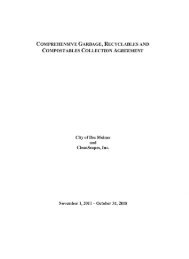CITY OF DES MOINES SHORELINE MASTER PROGRAM
CITY OF DES MOINES SHORELINE MASTER PROGRAM
CITY OF DES MOINES SHORELINE MASTER PROGRAM
Create successful ePaper yourself
Turn your PDF publications into a flip-book with our unique Google optimized e-Paper software.
Des Moines Shoreline Inventory and Characterization<br />
Species<br />
Pacific<br />
herring<br />
Documented<br />
Presence<br />
None (nearest is<br />
Quartermaster<br />
Harbor on<br />
Vashon I.)<br />
Table 8. Forage Fish Species<br />
Spawning Timing<br />
Quartermaster Harbor<br />
stock spawn January<br />
through mid-April<br />
Sand lance Segment F & G November 1 to<br />
February 15<br />
Preferred<br />
Spawning<br />
Substrate<br />
Eelgrass<br />
Fine sand, mixed<br />
sand and gravel,<br />
or gravel up to<br />
3cm<br />
Spawning Location<br />
Upper high tide limits to<br />
depths of 40 feet<br />
(typically between 0<br />
and –10 tidal elevation)<br />
From + 5 tidal elevation<br />
to higher high water line<br />
(from bays and inlets to<br />
current-swept beaches)<br />
Eulachon None Late winter/early spring Unknown Freshwater streams<br />
Longfin<br />
smelt<br />
None Winter Sand with aquatic<br />
vegetation<br />
Surf smelt Segments C, D,<br />
E, F, and G<br />
South Puget Sound<br />
stocks are fall-winter<br />
spawners (September<br />
to March)<br />
Mix of coarse<br />
sand and fine<br />
gravel (1-7mm)<br />
Freshwater streams<br />
Upper intertidal<br />
Sources: (Kerwin, 2001; O’Toole, 1995; KCDNR, 2001; Lemberg et al., 1997)<br />
Information on documented forage fish spawning activity was available from the WDFW (2004).<br />
No Pacific herring, eulachon, or longfin smelt spawning areas are currently documented in any<br />
of the shoreline inventory segments (WDFW, 2004). However, it is fair to assume that they all<br />
utilize the nearshore areas for feeding and migration. King County DNR (2001), WDFW (2004),<br />
and Kerwin and Nelson (2000) document surf smelt spawning areas in a small stretch of<br />
Segment C, between the unnamed creek and McSorley Creek; in Segment D near the mouth of<br />
McSorley Creek; and from the lower portion of Segment E (south of the Woodmont Creek<br />
mouth) extending through Segments F and into portions of Segment G. A sand lance spawning<br />
area is mapped along the shoreline from the mouth of Redondo Creek (Segment F) and<br />
throughout all of Redondo Beach (Segment G) (Kerwin and Nelson, 2000; WDFW, 2004; and<br />
KCDNR, 2001).<br />
Nearshore modifications impact potential forage fish habitat in the following ways:<br />
• Development impacts the shoreline, particularly marinas and boat ramps, which bury<br />
spawning habitat, introduce the potential for repeated disturbance, and potentially alter<br />
nearshore hydrology;<br />
• Sewer outfalls introduce pollutants and nutrients to the nearshore;<br />
• Overwater structures shade intertidal vegetation and may alter nearshore hydrology;<br />
• Riprap revetments and bulkheads impound sediment in bluffs such that fine-grained<br />
spawning beach sediment is not replenished (ongoing net-shore drift decreases spawning<br />
habitat); and<br />
• Riprap revetments and vertical bulkheads alter nearshore hydrology and may increase<br />
wave energy on intertidal areas.<br />
March 2005 Page 37



